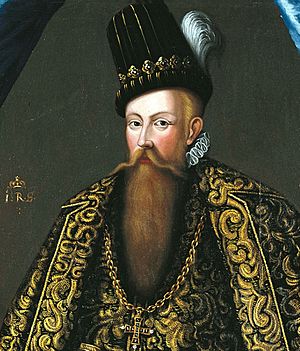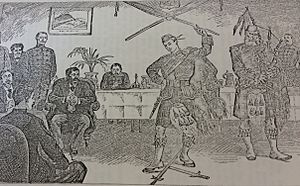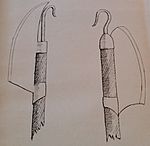Scottish sword dances facts for kids
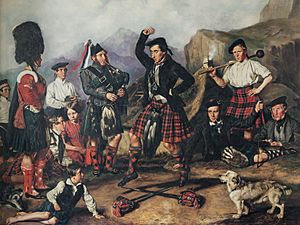
The Sword dance is one of the most famous Highland dances from Scotland. It's a very old war dance, with records showing it was performed as early as the 1400s. In this dance, the performer usually crosses two swords on the ground. This makes an "X" or "+" shape. The dancer then moves around and within the four sections of the swords.
Similar dances can be found in other parts of the world. These include the Welsh and English Morris dance, and dances in Austria, Germany, and France.
- The Ghillie Callum is the most common Scottish sword dance. The dancer crosses two swords and dances around them.
- The dirk dance is another type. It involves one or two dancers, each holding a single dirk (a type of dagger).
Contents
History of the Scottish Sword Dance
How the Dance Began
There's a fun old Scottish story about how the sword dance began. It talks about a person named Gillidh Callum. The story says he was Noah's bagpiper! According to these old tales, Noah once crossed two vines and danced over them. Gillidh Callum played the bagpipes, and that's how the dance supposedly started. This story connects the dance to ancient times.
Early Traditions
The Sword Dance has been a part of Scottish culture for a long time. People have been performing it since at least the 1400s. It was often seen as a war dance. It was also performed at special events in the Scottish Royal court.
Old kings and clan chiefs used to hold Highland Games. These games helped them choose their best fighters. Performing Highland dances like the Sword Dance showed a man's strength, stamina, and quickness. The earliest records also say that bagpipes always played music for the dance. The main rule is to cross two swords on the ground. Then, the dancer moves around and inside the four parts of the "X" or "+" shape.
One of the first mentions of these dances in Scotland is from the Scotichronicon. This book was put together in the 1440s. It talks about King Alexander III's wedding in 1285.
Musicians played many kinds of pipe music, including the sound of bagpipes. Behind them, others performed a war-dance with tricky weaving steps. At the very back, there was a strange figure. It was hard to tell if it was a person or a ghost. It seemed to float instead of walk. When it looked like it would disappear, the whole group stopped. The music and dancing suddenly froze.
When Mary, Queen of Scots married the French prince in 1558, there were big parties in Edinburgh. A sword dance was part of the fun. The dancers wore special costumes with bells. In 1573, Scottish soldiers were said to have danced for the Swedish King, John III. This happened at a big dinner in Stockholm Castle. The dance was part of a secret plan to attack the King. The dancers could carry their weapons without anyone getting suspicious. Luckily for the King, the signal to attack was never given.
A sword dance was also performed for Anne of Denmark in Edinburgh in 1590. Seventeen sword dancers wore bells and new Highland clothes. Scottish courtiers danced for Anne of Denmark again in 1604. This time it was at Hampton Court. Their dance was compared to a Spanish matachin dance.
A mix of sword dance and acrobatics was performed for King James VI in 1617. It was done again for King Charles I in 1633. The Skinners and Glovers of Perth performed it. The 1633 show was written down:
The King’s chair was set by the River Tay. There was a floating stage made of wood. Thirteen of our Glover brothers danced on it. They wore green caps, silver strings, red ribbons, and white shoes. They had bells on their legs and shining swords in their hands. They danced our sword dance with many hard moves. Five dancers were below, and five were on their shoulders. Three dancers moved through their feet and around them. They drank wine and broke glasses. Thank God, it was done without anyone getting hurt.
Different Kinds of Sword Dances
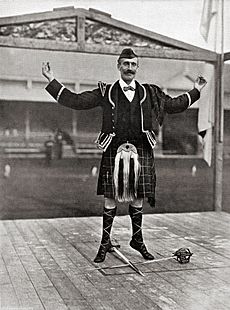
Many old Highland dances are now lost. But some were once performed with traditional weapons. These included the Lochaber axe, the broadsword, and a mix of targe (a shield) and dirk.
An old song from the Isle of Skye called Buailidh mi thu anns a' cheann means "I will break your head." This might mean that some dances involved a type of weapon play set to music. "Breaking the head" was the winning move in stick-fighting games. If blood ran an inch above the eyebrow, the person lost.
C. N. McIntyre North wrote about a Sword Dance in his 1880 book. He described nine steps for a clockwise-moving dance. The first step set the rhythm for the tune "Gillie Calliun."
A fighting sword dance called the Highland Dirk Dance still exists. It is often linked to other sword dances like "Macinorsair" or the "Bruicheath" (Battle Dance). These dances are mentioned in many old writings. They might have been performed in different ways. Sometimes two people would dance as if fighting. Other times, it was a solo performance.
Sword Dance in Highland Regiments
Highland Regiments (army groups) have kept the traditional dance alive. But they have made some changes. To get ready for the Sword Dance, a soldier puts two swords on the ground in a cross shape. Then, to the sound of bagpipes, he dances. He follows a set series of steps and movements around the swords. He keeps his back straight, arms raised, and hands in a special pose.
More than one person can perform the dance. There is a long history of showing off and competing with more crossed swords and dancers. Over time, this dance became a key part of bagpipe band performances.
The crossed weapons in the traditional sword dance are not always swords. Dancing around crossed Lochaber axes is mentioned as an older version of the dance. The Broadsword was a type of sword worn by officers in Highland Regiments. It is sometimes wrongly called a claymore. A claymore is actually a much larger, two-handed weapon.
The original Broadswords Dance is described in MacLellan’s book. Its steps are simpler than what you might see today. It is not a very old dance, and it did not start in the army regiments.
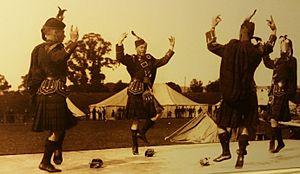
Links
- Illustration from The Book of the Club of True Highlanders showing step patterns and timing of the Sword Dance: [1]


